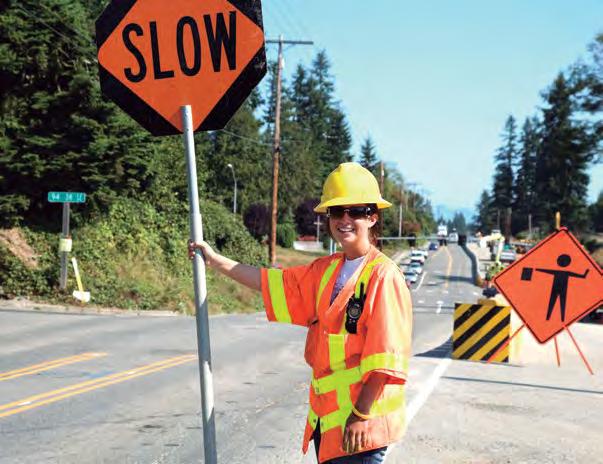
3 minute read
TRAFFIC MANAGEMENT RULES
TRAFFIC MANAGEMENT – THE RULES
Don’t take a detour on safety when it comes to managing traffic on civil work sites. CCF NSW walks you through the rules and all the legislation, standards and guides you need to help you protect road workers and road users during construction and maintenance.
Advertisement
Under the Work Health and Safety Regulations (NSW) 2017, employers have obligations to ensure a safe workplace. When it comes to working on public roads, footpaths, road verges, bicycle paths and other civil work sites where traffic needs controlling, these include: ¿ preventing injury to workers due to vehicle hazards within the work site; ¿ protecting workers from oncoming or passing traffic; and ¿ protecting road users from hazards within the work site. What is Temporary Traffic Management? The purpose of temporary traffic management is to create a safe work area when construction, maintenance and other activities are being done on or near a road. It controls traffic movement through or past a work site, to achieve safety and reduce inconvenience for both road workers and road users. Temporary traffic management practices in New South Wales need to be conducted in accordance with: ¿ Road Transport Act (NSW) 2013 No. 18 ¿ AS 1742.3:2019 Manual of uniform traffic control devices, Part 3 - Traffic control for works on roads ¿ Transport for NSW - Traffic control at work sites, Technical Manual, Version 6.1 2022 ¿ Transport for NSW - G10 Traffic Management – Edition 7 / Revision 5, August 2020 ¿ Austroads Guide to Temporary Traffic Management Conduct a Risk Assessment Temporary traffic management commonly uses traffic control devices, such as signs and traffic signals, however, before you start ordering any traffic control devices, you should do a risk assessment to ensure your methods of reducing risk for your workers and others are the right ones. Consider the following factors in your risk assessment: ¿ scope and duration of the project, ¿ site layout, and specific hazards within the work site, such as excavations, ¿ traffic density, flow and speed, ¿ time required to perform activities, ¿ time of day when tasks are to be performed, ¿ pedestrian movement, ¿ environmental factors such as wet conditions or poor visibility,
¿ risks associated with plant and equipment, ¿ experience and training of workers, ¿ alternate routes available for road users and pedestrians, should a road or footpath be partially or fully closed. For guidance on doing a risk assessment, see the NSW Code of Practice How to manage work health and safety risks (August 2019), at safework.nsw.gov.au
Implement Control Measures
You must use the hierarchy of control, so far as reasonably practicable, to work out the best control measures for your work site.
Use the highest-ranked control that is practical for
controlling the risks to the health and safety of your workers and others. Only use lower-ranked controls as a last resort or until a more effective way of controlling risk can be used. Sometimes using more than one control measure could be the most effective way to reduce the exposure to hazards.
Hierarchy of Controls
Elimination: close the roads.
Substitution: program the work to be conducted when there is no risk or significantly less risk present. Isolation: use approved temporary safety barriers to isolate workers and work activities from road users.
Engineering controls: use signs such as ‘workers ahead’ and cones, bollards, delineators and barrier boards.
Administrative controls: implement safe work practices; provide your workers with training, instruction and information so they can do their work near traffic safely. Personal protective and safety equipment: make sure your workers wear high visibility garments when working near moving traffic or plant. These garments should meet the requirements of AS/ NZS 4602.1:2011: High visibility safety garments – garments for high-risk applications.
Regular Review
¿ Top Tip: Document all reviews you undertake.
Due to the nature of civil works and changing risks, it is important to regularly review your temporary traffic management plan, and update when needed. This will ensure you continue to effectively control the risks to the health and safety of your workers and others.
For further advice, please call the CCF NSW Compliance Support Unit on (02) 9009 4000.
YOUR RECRUITMENT PARTNER

CGC Recruitment is the connection between great engineering projects and the people who make them happen. We place top talent in construction and engineering roles and recruit for Tier 1, Tier 2 and Mid-Tier civil contractors specifically focusing on Rail, Road, and Utility infrastructure projects throughout NSW. We are currently recruiting Project Managers, Construction Managers, Engineers, Estimators, and Commercial & Contract Managers working on Sydney Metro, West Sydney Airport, West Connex and other Major Road Tunnelling and Utility projects.










